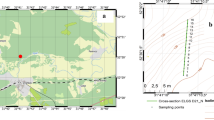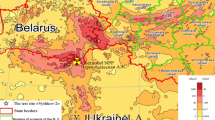Abstract
The classification of soil catenae at the Ob River basin is developed and applied. This classification reflects the diverse geochemical conditions that led to the formation of certain soil bodies, their combinations and the migration fields of chemical elements. The soil and geochemical diversity of the Ob River basin catenae was analyzed. The vertical and lateral distribution of global fallouts cesium-137 was studied using the example of the four most common catenae types in Western Siberia tundra and taiga. In landscapes of dwarf birches and dark coniferous forests on gleysols, cryosols, podzols, and cryic-stagnosols, the highest 137Cs activity density and specific activity are characteristic of the upper soil layer of over 30% ash, while the moss-grass-shrub cover is characterized by low 137Cs activity density and specific activity. In landscapes of dwarf birches and pine woods on podzols, the maximum specific activity of cesium-137 is typical for moss-grass-shrub cover, while the maximum reserves are concentrated in the upper soil layer of over 30% ash. Bog landscapes and moss-grass-shrub cover are characterized by a minimum activity of 137Cs, and its reserves in soil generally decrease exponentially with depth. The cesium-137 penetration depth increases in oligotrophic histosols from northern to middle taiga landscapes from 10–15 to 40 cm. 137Cs is accumulated in oligotrophic histosols for increases in pH from 3.3 to 4.0 and in concretionary interlayers of pisoplinthic-cryic-histic-stagnosols. Cryogenic movement, on the one hand, leads to burying organic layers enriched in 137Cs and, on the other hand, to deducing specific activity when mixed with low-active material from lower soil layers.
Similar content being viewed by others

References
Aleksakhin, R.M., Radioactive contamination as a type of soil degradation, Eurasian Soil Sci., 2009, vol. 42, no. 12, pp. 1386–1396.
Almgren, S., Nilsson, E., Erlandsson, B., et al., GIS supported calculations of 137Cs deposition in Sweden based on precipitation data, Sci. Total Environ., 2006, vol. 368, pp. 804–813.
Arinushkina, E.V., Rukovodstvo po khimicheskomu analizu pochv (A Manual on Chemical Analysis of Soil), Moscow: Moscow State Univ., 1962.
Birch, G.F. and McCready, S., Catchment condition as a major control on the quality of receiving basin sediments, Sydney: Harbour, Australia, Sci. Total Environ., 2009, vol. 407, pp. 2820–2835.
Bogdanova, M.D., Methods of small-scale soil geochemical mapping, Cand. Sci. (Geogr.) Dissertation, Moscow: Moscow State Univ., 2004.
Boltneva, L.I., Izrael’, Yu.A., Ionov, V.A., and Nazarov, I.M., Global 137Cs and 90Sr contamination and external radiation level in the USSR, At. Energ., 1977, vol. 42, no. 5, pp. 355–360.
Collins, A.L., Walling, D.E., Webb, L., et al., Apportioning catchment scale sediment sources using a modified composite fingerprinting technique incorporating property weightings and prior information, Geoderma, 2010, vol. 155, pp. 249–261.
Comans, R.N.J., Hilton, J., Voitsekhovitch, O., et al., A comparative study of radiocesium mobility measurements in soils and sediments from the catchment of a small upland oligotrophic lake (Dewoke Water, U.K.), Water Res., 1998, vol. 32, no. 9, pp. 2856–2855.
Generalova, V.A. and Onoshko, M.P., Adsorption of technogenic radionuclides and trace elements by iron-bearing and clay deposits, Razved. Okhr. Nedr, 2006, no. 3, pp. 22–26.
GOST (State Standard) 11306-83. Turf and products of its processing. Methods for the determination of ash content, 1985.
Karavaeva, N.A., Zabolachivanie i evolyutsiya pochv (Swamping and Soil Evolution), Moscow: Nauka, 1982.
Kasimov, N.S., Gennadiev, A.N., and Lychagin, M.Yu., Background geochemical differentiation of landscapes and monitoring of natural environment, in Monitoring fonovogo zagryazneniya prirodnoi sredy (Monitoring of Background Contamination of Natural Environment), Moscow: Gidrometeoizdat, 1989, vol. 5, pp. 162–179.
Klassifikatsiya i diagnostika pochv Rossii (Classification and Diagnostics of Russian Soils), Smolensk: Oikumena. 2004.
Korobova, E.M. and Korovaykov, P.A., Landscape and geochemical approach to drawing up a soil distribution profile for chernobyl radionuclides in distant areas, in Proceedings of the Seminar on Comparative Assessment of the Environmental Impact of Radionuclides Released during Three Major Nuclear Accidents: Kyshtym, Windscale, Chernobyl. Luxembourg, 1990, vol. 2, pp. 309–326.
Korobova, E.M., Chizhikova, N.P., and Linnik, V.G., Distribution of 137Cs in particle-size fractions and in the profiles of alluvial soils on floodplains of the Iput and its tributary Buldynka River (Brynsk oblast’), Eurasian Soil Sci., 2007, vol. 40, no. 4, pp. 367–379.
Kuznetsov, V.A. and Generalova, V.A., Radionuclides and colloidal manganese compounds in landscapes, Litosfera, 1994, no. 1, pp. 146–159.
Kvasnikova, E.V., Vakulovsky, S.M., Gordeev, S.K., Zhukova, O.M., Konstantinov, S.V., Manzon, D.A., and Yakhryushin, V.N., Radiation monitoring in Bryansk Polesye twenry-one years after the Chernobyl NPP accident, Russ. Meteorol. Hydrol., 2009, vol. 34, no. 7, pp. 454–463.
Linnik, V.G., Brown, J.E., Dowdall, M., et al., Patterns and inventories of radioactive contamination of island sites of the Yenisey River, Russia, J. Environ. Radioact., 2006, vol. 87, pp. 188–208.
Miroshnikov, A.Yu. and Semenkov, I.N., Migration of global radioactive fallout to the Arctic Ocean (on the example of the Ob River drainage basin), Radiat. Prot. Dosim., 2012, vol. 152, nos. 1–3, pp. 89–93.
Palsson, S.E., Howard, B.J., Bergan, T.D., et al., A simple model to estimate deposition based on a statistical reassessment of global fallout data, J. Environ. Radioact., 2013, vol. 121, pp. 75–86.
Panitsky, A.V., Lukashenko, S.N., and Magasheva, R.Yu., Particularities of radionuclides’ vertical distribution in soils of former Semipalatinsk test site, Fundam. Res., 2013, vol. 10, no. 10, pp. 2231–2236.
Pavlotskaya, F.I., Migratsiya radioaktivnykh produktov global’nykh vypadenii v pochve (Migration of Radioactive Products of Global Fallout in Soil), Moscow: Atomizdat, 1974.
Popov, V.E., Effect of 137Cs accumulation by organomineral coarse particles in sandy soils contaminated during the Chernobyl NPP accident, Eurasian Soil Sci., 2006, vol. 39, no. 3, pp. 307–313.
Samonova, O.A., Kasimov, N.S., and Aseeva, E.N., Mobile forms of metals in the soils of erosion forms in the southeastern part of the Smolensk-Moscow Upland, Vestn. Mosk. Univ. Ser. 5: Geogr., 2011, vol. 5, no. 6, pp. 67–75.
Semenkov, I.N., Aseeva, E.N., and Terskaya, E.V., Geochemical structure of forest-steppe catenas of balka drainage area in the Upa River basin, Vestn. Mosk. Univ. Ser. 5 Geogr., 2013, no. 6, pp. 68–75.
Semenkov, I.N. and Usacheva, A.A., Cesium-137 as a tracer of current soil turbations, Fundam. Res., 2013, vol. 7, no. 10, pp. 1475–1481.
Semenkov, I.N. and Miroshnikov, A.Yu., Quantitative evaluation of runoff of global radiocesium fallout in landscapes of the Ob River basin, GeoEcol., Eng. Geol., HydroGeol., GeoCryol., 2014, no. 3, pp. 222–230.
Shcheglov, A.I., Tsvetnova, O.B., and Klyashtorin, A.L., Biogeokhimiya tekhnogennykh radionuklidov v lesnykh ekosistemakh (Biogeochemical Migration of Technogenic Radionuclides in Forest Ecosistems), Moscow: Nauka, 2001.
Shcheglov, A.I., Tsvetnova, O.B., and Bogatyrev, L.G., The role of forest cover in the migration of elements—technogenic pollutants, in Problemy radioekologii i pogranichnykh distsiplin (Issues of Radioecology and Related Disciplines), 2005, vol. 6, Yekaterinburg: Izd. Ural. Univ., pp. 248–268.
Sobotovich, E.V., Ol’khovik, Yu.A., Golovko, N.V., et al., Washout as a method to determine the composition of 137Cs and 90Sr migratory forms in bottom sediments, At. Energ., 1992, vol. 72, no. 1, pp. 69–72.
Sources and effects of ionizing radiation, in UNSCEAR 2008 Report to the General Assembly with Scientific Annexes, New York: United Nations, 2010, vol. 1.
Strandberg, M., Radiocesium in a Danish pine forest ecosystem, Sci. Total Environ., 1994, vol. 157, pp. 125–132.
Sudakova, E.A., Ryabinina, N.I., Markova, T.A., et al., Cartographic investigation method of the modern spatial regional peculiarities of the caesium-137 contamination of Russia. Research report no. 9805-64512, Inform. Byull. RFFI, 1999, no. 7.
Tikhomirov, F.A. and Shcheglov, A.I., Main investigation results on the forest radioecology in the Kyshtym and Chernobyl accident zones, Sci. Total Environ., 1994, vol. 157, pp. 45–57.
Urusevskaya, I.S., Soil catenas in the Russian non-chernozemic zone, Pochvovedenie, 1990, no. 9, pp. 12–27.
Velichkin, V.I., Borisenko, E.N., Miroshnikov, A.Yu., et al., Radiogeoecological research in impact zones of nuclear industry, in Geokhimiya landshaftov i geografiya pochv. K 100-letiyu M.A. Glazovskoi (Landscape Geochemistry and Soil Geography. To the 100th Birthday of M.A. Glazovskaya), Moscow: APR, 2012, pp. 316–344.
Zaharescu, D.G., Hooda, P.S., Soler, A.P., et al., Trace metals and their source in the catchment of the high altitude lake Respomuso, Central Pyrenees, Sci. Total Environ., 2009, vol. 407, pp. 3546–3553.
Author information
Authors and Affiliations
Corresponding author
Additional information
Original Russian Text © I.N. Semenkov, A.A. Usacheva, A.Yu. Miroshnikov, 2015, published in Geologiya Rudnykh Mestorozhdenii, 2015, Vol. 57, No. 2, pp. 154–173.
This article is based on the report submitted at the Third Youth School of Institute of Geology of Ore Deposits, Petrography, Mineralogy and Geochemistry, Russian Academy of Sciences, December 2–6, 2013.
Rights and permissions
About this article
Cite this article
Semenkov, I.N., Usacheva, A.A. & Miroshnikov, A.Y. Distribution of global fallouts cesium-137 in taiga and tundra catenae at the Ob River basin. Geol. Ore Deposits 57, 138–155 (2015). https://doi.org/10.1134/S1075701515010055
Received:
Published:
Issue Date:
DOI: https://doi.org/10.1134/S1075701515010055



